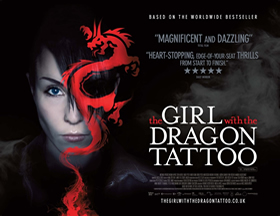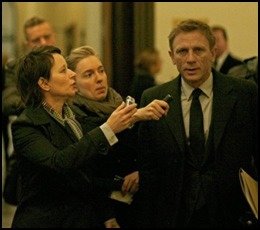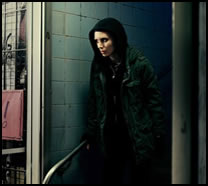The Girl with the Dragon Tattoo Review
December 21, 2011
By Nick Galasso
 Back in 2005 The Girl With the Dragon Tattoo, the first book in what has come to be known as “The Millennium Trilogy”, hit bookshelves in Sweden, a year after the death of its author, Stieg Larsson. It was closely followed by two sequels, The Girl Who Played With Fire and The Girl Who Kicked the Hornet’s Nest. The books didn’t really see much attention in America until an English-language version of Dragon Tattoo was released in 2008. Cut to three years, two more English-language editions of the sequels, and three Swedish film adaptations later, and we finally have the American film adaptation of the now immensely popular series, directed by David “I Can Do Whatever the Hell I Wanna Do At This Point In My Career” Fincher.
Back in 2005 The Girl With the Dragon Tattoo, the first book in what has come to be known as “The Millennium Trilogy”, hit bookshelves in Sweden, a year after the death of its author, Stieg Larsson. It was closely followed by two sequels, The Girl Who Played With Fire and The Girl Who Kicked the Hornet’s Nest. The books didn’t really see much attention in America until an English-language version of Dragon Tattoo was released in 2008. Cut to three years, two more English-language editions of the sequels, and three Swedish film adaptations later, and we finally have the American film adaptation of the now immensely popular series, directed by David “I Can Do Whatever the Hell I Wanna Do At This Point In My Career” Fincher.
During the mid-to-late-90s, Fincher had more of a cult following behind him, being known mostly as “that guy who directed Fight Club and Seven.” But since 2007, he has established himself as quite possibly one of the most prominent directors currently in the film industry, coming off a string of massive hits, including the underrated Zodiac and two overrated – although still pretty good – films: The Curious Case of Benjamin Button and The Social Network. This adaptation is another notch on the man’s belt, and rightfully so, as this material is a perfect fit for him. Tonally, it harkens back to his Seven and Fight Club days, while still retaining the massive scope that has been a prominent force in all his most recent films. So this is like a match made in Heaven with him directing this.
There’s a very specific brooding feel that went along with the original “Millennium Trilogy,” that Fincher captures perfectly. We are dealing with very complex characters in a very convoluted story. When the story opens up, there really isn’t all that much going on for them that’s positive. Solving the main conflict of the story seems to be the most positive thing the characters have going for them at the moment, and we root for them all the way. Although, even as we root for them, there’s still an underlying cynical edge to the film. We want them to have everything resolved, although we never immediately think that they’ll all be able to just live happily ever after once the main issue is taken care of. Even once the story is over, while there may be some improvements in some of the characters’ own personal stories, we are left wondering how much good in the long run these improvements may have (before we move on to the next book, at least). Fincher doesn’t beat around the bush, here, in recreating this tone for his film. While he still wants us to root for his characters to resolve the main storyline, he never forgets that cynical, edgy, and sometimes brutal tone that makes the “Millennium Trilogy” such an interesting read.
 The film follows journalist Mikael Blomkvist (played by Daniel Craig), a journalist for a fictional magazine known as Millennium (for which the trilogy got its name), in the aftermath of a huge scandal. He is accused of libel after he makes allegations of corruption about billionaire industrialist Hans Wennerstrom, having obtained his information from unreliable sources. For this, he is sued and humiliated. He soon after meets with a retired CEO named Henrik Vanger (Christopher Plummer), who offers him a new story. His great-niece Harriet disappeared 36 years earlier, and he believes that a member of his family murdered her. Vanger asks Blomkvist to write a story on his family’s history in order to find out who Harriet’s murderer was. In exchange, Vanger promises a hefty financial reward as well as solid evidence against Wennerstrom. Needing help for this case, Blomkvist turns to Lisbeth Salander (Rooney Mara), a surveillance agent whom Vanger had previously hired – before hiring Blomkvist – to do a background check on Blomkvist.
The film follows journalist Mikael Blomkvist (played by Daniel Craig), a journalist for a fictional magazine known as Millennium (for which the trilogy got its name), in the aftermath of a huge scandal. He is accused of libel after he makes allegations of corruption about billionaire industrialist Hans Wennerstrom, having obtained his information from unreliable sources. For this, he is sued and humiliated. He soon after meets with a retired CEO named Henrik Vanger (Christopher Plummer), who offers him a new story. His great-niece Harriet disappeared 36 years earlier, and he believes that a member of his family murdered her. Vanger asks Blomkvist to write a story on his family’s history in order to find out who Harriet’s murderer was. In exchange, Vanger promises a hefty financial reward as well as solid evidence against Wennerstrom. Needing help for this case, Blomkvist turns to Lisbeth Salander (Rooney Mara), a surveillance agent whom Vanger had previously hired – before hiring Blomkvist – to do a background check on Blomkvist.
This sounds like a lot to take in, right? Well, yeah, that’s because it is. And this is just the basic premise of both the novel and the film. And even within that basic premise, there’s still a ton of other stuff that is explored in between each major dramatic beat. This leads to a bit of a problem that I had with this film. It clocks in at 2 hours and 40 minutes – a popular runtime for most of Fincher’s recent movies. This is not necessarily a bad thing in and of itself. There are plenty of great films that are 3 hours or more that do not suffer from their lengthy runtime. However, Dragon Tattoo does suffer a little bit from its 160 minute length.
The problem is that there seemed to be a large desire to stay as true to the book as it possibly can. And this possibly could have stemmed from the way in which the Swedish films adapted the story. In the Swedish films, gone are a good chunk of subplots, including certain aspects of Blomkvist and Salander’s personal stories, as well as Vanger’s involvement in the Wennerstrom case. Vanger’s case is what’s at the front and center for the majority of the film, while Wennerstrom, as well as the essentials to both Blomkvist and Salander’s backgrounds were placed as the bookends to the Vanger case, all seemingly unrelated to each other. While these immense changes were handled very well, I guess there was still a desire to work what happened according to the original novel back into the American adaptation.

And by showing us what happened according to the original novel, it just gives us a lot to take in. At times, it’s so much to the point that we really don’t know which part of the film we’re supposed to give most of our attention to. This was the major problem of this film: The focus. While the Swedish film sacrificed a lot of subplots in order to focus on the main story more, it worked effectively because we knew what story we had to give most of our attention to. At the same time, however, it still had a firm grasp of the subplots, as we are only shown the heart of each subplot, and not every little minor detail that would lead to the film dedicating so much time to them. With the American adaptation, there’s much more attention to the little details, even within the subplots (and just so you know, there was still stuff that was cut from the original novel). At times, it feels like there’s so much more attention on characters’ back stories and all the little ways in which certain characters are connected that we almost forget, “Oh yeah, there’s still a murder mystery we have to get to the bottom of! Let’s get back to that, shall we?” It proves for a jarring and disorienting feel at times, and it also makes for those 2 hours and 40 minutes to go by a little slower than they should be.
This is sad because the film starts off with such a bang. It contains what is now probably one of my favorite opening sequences in a film. Trent Reznor – better known for his work with the band Nine Inch Nails – composes a cover of Led Zeppelin’s “The Immigrant Song” that plays against some truly visually striking images of both Salander and Blomkvist during the opening credits. It gets us pumped up and seems to promise us that we’re in for one of the most intense thrill rides of our lives, ever. What’s disappointing is, while we’re certainly in for a very good thrill ride, it’s nowhere near like the one that the opening credit sequence seems to promise us.
Although as much as I criticize the film for its lack of focus, what’s odd about it is that it’s one of those cases where it still does a good job on whatever it may be focusing on at the time. While it may be jarring at times to transition from a subplot to the main plot, we are still very invested in both the subplot and the main plot, if you get what I’m saying. When we spend too much time on all the backstories of Blomkvist and Salander, there’s still an overall feeling of engagement with the characters. Never once do we feel disinterested in what is going on with them. Fincher’s direction is one of the key elements driving each sequence, being accompanied by a haunting score – also composed by Reznor – that perfectly fits the mood for each scene. Also, both Daniel Craig and Rooney Mara do fantastic jobs as Blomkvist and Salander, respectively. They both capture the right essence of their respective characters and give us the emotional involvement we need as an audience to be invested in them for such a complex narrative.
So overall, is this adaptation of The Girl With the Dragon Tattoo worth seeing? Yes, without a doubt. While it may not be for everybody, this is a worthy adaptation of Stieg Larsson’s novel, as well as another solid entry in David Fincher’s library. While it doesn’t quite pack the emotional punch that the original novel or the Swedish adaptation did, it still does pack quite a punch, and you definitely won’t be disappointed by it. Just as long as you have the right amount of focus and patience.
4 out of 5
~
